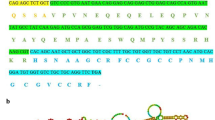Abstract
Hepcidin, a novel gene encoded, 25 residue, 2–3 KDa cysteine rich cationic peptide synthesized in liver cells play an important role in iron metabolism in addition to its antimicrobial activity. In this study hepcidin cDNA expressed on hepatocytes of Bubalus bubalis has been characterized and the antibacterial activity of buffalo hepcidin analog has been determined. The complete buffalo hepcidin sequence is of 324 bp and have an ORF of 249 nucleotides from 14 to 262. The sequence analysis at nucleotide level showed homology of 98.0% with cattle, 84.3% with pig, whereas with human, chimpanzee and gorilla 80.3%, 80.7% and 81.5% respectively. The percent identity of buffalo hepcidin cDNA to that of japanese macaque, dog, gibbon, mouse and norway rat are81.9%, 79.9%, 79.9%, 67.9% and 65.9% respectively. The hepcidin cDNA of buffalo and cattle showed a total difference of five nucleotides at position 15, 108, 225, 240 and 246 with no difference in deduced amino acid sequence. The base A15, C108, A225, C240, A246 in cattle are replaced by G15, G108, G225, T240 and G246 respectively in buffalo. The deduced amino acid sequence of buffalo preprohepcidin consists of 82 amino acids containing 10 strongly basic, 3 strongly acidic, 27 hydrophobic and 29 polar amino acids. The predicted molecular weight and isoelectric point (PI) for the peptide is 8883.67 Daltons and 8.804 respectively. Phylogenetic analysis both at nucleotide and amino acid level indicate that buffalo and cattle hepcidin sequences comprises one clad which is more closely related to pig compared to human. The chemically synthesized analog of buffalo hepcidin using Fmoc chemistry in solid phase had antibacterial activity.



Similar content being viewed by others
References
Andreu D, Rivas L (1998) Animal antimicrobial peptides: an overview. Biopolym Pept Sci 47:415–433
Badial PR, Oliveira FJP, Cagnini DQ, Cunha PH, Araujo JP Jr, Winand NJ, Borges AS (2010) Identification, characterization and expression analysis of hepcidin gene in sheep. Res Vet Sci. Aug 17. [Epub ahead of print]
Chen SL, Xu MY, Ji X, Yu GC (2004) Analysis of immune related genes expressed in red sea bream (Chrysops major) spleen. Aquaculture 240:115–130
Cruickshank R, Duguid JP, Marmion BP, Swain RHA (1975) Medical microbiology, vol. 2, 12th edn. Churchill Livingstone, New York, p 196
Fry MM, Liggett JL, Baek SK (2004) Molecular cloning and expression of canine hepcidin. Vet Clin Pathol 33(4):223–7
Gagliardo B, Kubat N, Faye A, Jaouen M, Durel B, Deschemin JC, Canonne-Hergaux F, Sari MS, Vaulont S (2009) Pro-hepcidin is unable to degrade the iron exporter Ferroportin unless maturated by a furin-dependent process. J Hepatol 50:394–401
Ganz T (2003) Hepcidin, a key regulator of iron metabolism and mediator of anemia of inflammation. Blood 102:783–788
Hancock REW, Lehrer R (1998) Cationc peptides: a new source of antibiotics. Trends Biotechnol 16(2):82–88
Krause A, Neitz S, Mägert H-J, Schulz A, Forssmann W-G, Schulz-Knappe P, Adermann K (2000) LEAP-1, a novel highly disulfide-bonded human peptide exhibits antimicrobial activity. FEBS Lett 480:147–150
Lehrer RI, Ganz T (1999) Antimicrobial peptides in mammalian and insect host defense. Curr Opin Immunol 11:23–27
Merrifield RB (1963) Solid phase peptide synthesis 1. The synthesis of a tetrapeptide. J Am Chem Soc 85:2149–2154
Oliveira FJP, Badial PR, Cunha PH, Cruz TF, Araujo JP Jr, Divers TJ, Winand NJ, Borges AS (2010) Cloning, sequencing and expression analysis of the equine hepcidin gene by real-time PCR. Vet Immunol Immunopathol 135(1–2):34–42
Park CH, Valore EV, Waring AJ, Ganz T (2001) Hepcidin: a urinary antimicrobial peptide synthesized in the liver. J Biol Chem 276:7806–7810
Pigeon C, Liyin G, Corseland B, Leroyer P, Turlin B, Bressot P, Loreal O (2001) A new mouse liver specific gene encoding a protein homologous to human antimicrobial peptide hepcidin, is overexpressed during overload. J Biol Chem 276:7811–7819
Robson KJ (2003) Hepcidin and its role in iron absorption. Gut 53:617–61
Sambrook J, Russell T (2001) Molecular cloning: A laboratory manual, 3rd edn. Cold Spring Harbor Laboratory Press, New York
Schroder JM (1999) Epithelial antimicrobial peptides; innate local host response elements. Cell Mol Life Sci 56:32–46
Selsted ME, White SH, Wimley WC (1995) Structure, function, and membrane integration of defensins. Curr Opin Struct Biol 5(4):521–527
Vizioli J, Salzet M (2002) Antimicrobial peptides from animals: focus on invertebrates. Trends Pharmacol Sci 23(11):494–496
Acknowledgements
The authors are grateful to Director, IVRI for providing necessary facilities and ICAR, New Delhi for financial assistance.
Conflict of interest statement
None of the authors of this paper has a financial or personal relationship with other people or organizations that could inappropriately influence or bias the content of the paper.
Author information
Authors and Affiliations
Corresponding author
Rights and permissions
About this article
Cite this article
Khangembam, V.C., Kumar, A. Buffalo hepcidin: characterization of cDNA and study of antimicrobial property. Vet Res Commun 35, 79–87 (2011). https://doi.org/10.1007/s11259-010-9452-8
Accepted:
Published:
Issue Date:
DOI: https://doi.org/10.1007/s11259-010-9452-8




